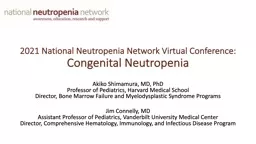

Professor of Pediatrics Harvard Medical School Director Bone Marrow Failure and Myelodysplastic Syndrome Programs Jim Connelly MD Assistant Professor of Pediatrics Vanderbilt University Medical Center ID: 911502
Download Presentation The PPT/PDF document "Akiko Shimamura, MD, PhD" is the property of its rightful owner. Permission is granted to download and print the materials on this web site for personal, non-commercial use only, and to display it on your personal computer provided you do not modify the materials and that you retain all copyright notices contained in the materials. By downloading content from our website, you accept the terms of this agreement.
Slide1
Akiko Shimamura, MD, PhDProfessor of Pediatrics, Harvard Medical SchoolDirector, Bone Marrow Failure and Myelodysplastic Syndrome ProgramsJim Connelly, MDAssistant Professor of Pediatrics, Vanderbilt University Medical CenterDirector, Comprehensive Hematology, Immunology, and Infectious Disease Program
2021 National Neutropenia Network Virtual Conference:
Congenital Neutropenia
Slide2Bone Marrow Transplant Basics
A medical procedure to replace the patient’s diseased bone marrow with the bone marrow from a healthy donorIdentification of a healthy donor is accomplished through “HLA typing” of family members and/or unrelated volunteers for a suitable match
A sibling has a 25% of being a ”full HLA-match” and 50% chance of being a “half HLA-match”, also called a haploidentical donor
The degree of HLA match and other donor factors such as age are important for reducing the risk of transplant
HLA Family Typing
dkms.org
Slide3Bone Marrow Transplant BasicsTo accept the donor bone marrow, patients receive chemotherapy to eliminate their own diseased bone marrowHealthy bone marrow cells are collected from the donor and infused to the patient through a central venous catheterPatients are placed on immune suppression to promote slow growth of the new bone marrow
If the new bone marrow develops too quickly, the new donor immune system can be confused and attack healthy organs in a disorder called Graft-vs-Host Disease (GvHD)
Donor Collection Options
Slide4Indications for BMT in Congenital NeutropeniaHighly recommendedMDS/AML or MDS-associated cytogenetic abnormality
No response to G-CSFAplastic anemia/Bone marrow failure (SDS)Possibly recommendedHigh dose of G-CSF required for ANC still <2000 (SCN)ELANE
mutation with high risk of MDS/AML (SCN)
Intolerable side effects of G-CSF
Probably not recommended
Doing well on low dose G-CSF
Acquisition of CSF3R (SCN) or TP53 mutation (SDS)
Slide5Transplant Outcomes Based on Donor Type
Without MDS/AML
With MDS/AML
Literature Summary
1
80%
39%
SCNIR
2
78%
83%
EBMT
387%79%
Transplant Outcomes Based on Disease Status
1. Connelly et al. COH 2013
2. Zeidler et al. ASH 2014
3. Fioredda et al. Blood 2015
Fioredda et al. Blood 2015; 126(16): 1885-92
What Determines a Successful Transplant for SCN?
Slide6What Determines a Successful Transplant for SDS?
BMT Outcomes in European Cohort of SDS Patients
BMT Outcomes in CIBMTR Cohort of SDS Patients
Cesaro et al. BMT 2020; 55: 1796-1809.
Myers et al. BBMT 2020; 1446-1809.
Slide7What about new therapies for congenital neutropenia?New therapies are currently being investigated to treat congenital neutropenia, but a lot of “pre-clinical” research must be completed first before moving the therapy to a clinical trialFor patients with ELANE severe congenital neutropenia, treatment options under pre-clinical investigation include:Elastase (the protein made by the gene
ELANE) inhibitorsGenetic editing to remove the ELANE geneGenetic editing to repair the ELANE
gene
For patients with specific mutations in SDS, pre-clinical investigations include treatments to improve SBDS expression and function
Slide8SummaryCongenital neutropenia disorders have many different causes from germline mutations in genes important for neutrophil developmentTreatment with G-CSF has tremendously reduced the risk of severe infections, but patients remain at risk for AML/MDSThe development of new mutations in bone marrow cells (i.e. a somatic mutation) is common in congenital neutropenia
Screening for somatic mutations in congenital neutropenia is a relatively new instrument used by hematologists, but mutations may be benign or never progress to AML/MDSBone marrow transplant is curative of congenital neutropenia but is reserved for patients who have developed or are at high risk of severe complications
Slide9And Discussion
Questions